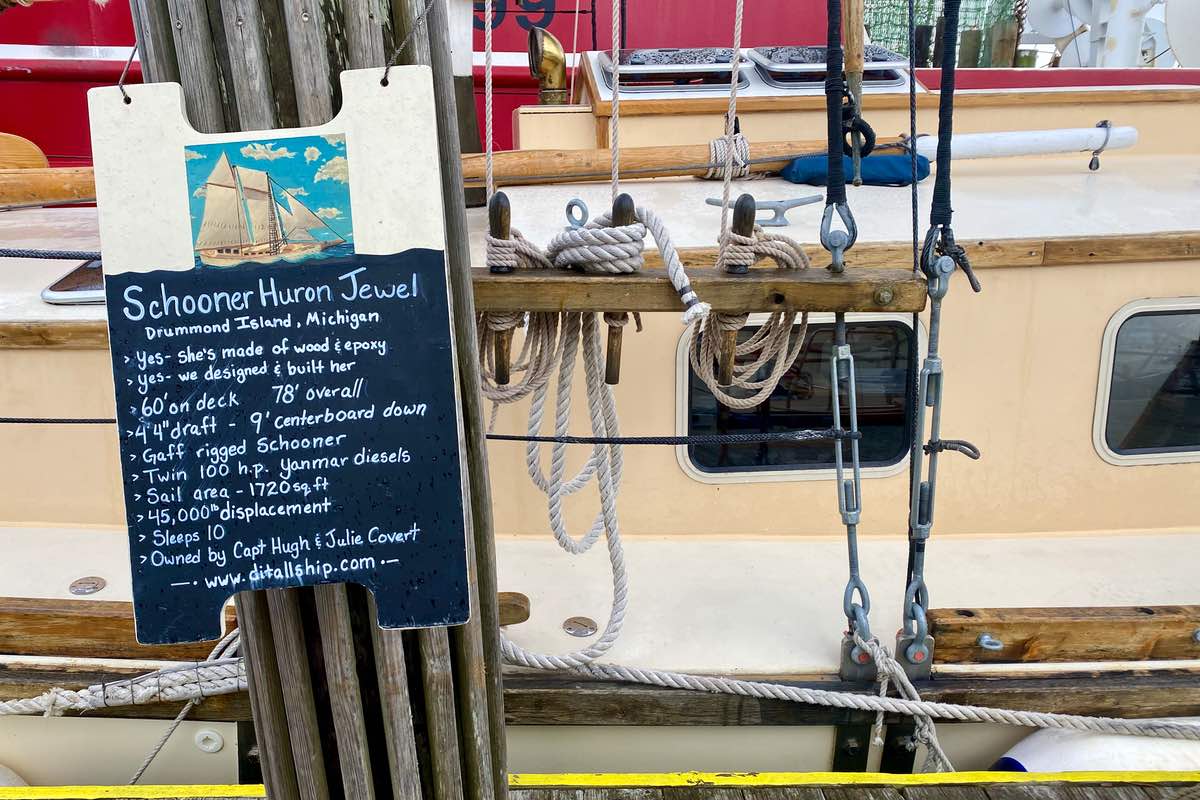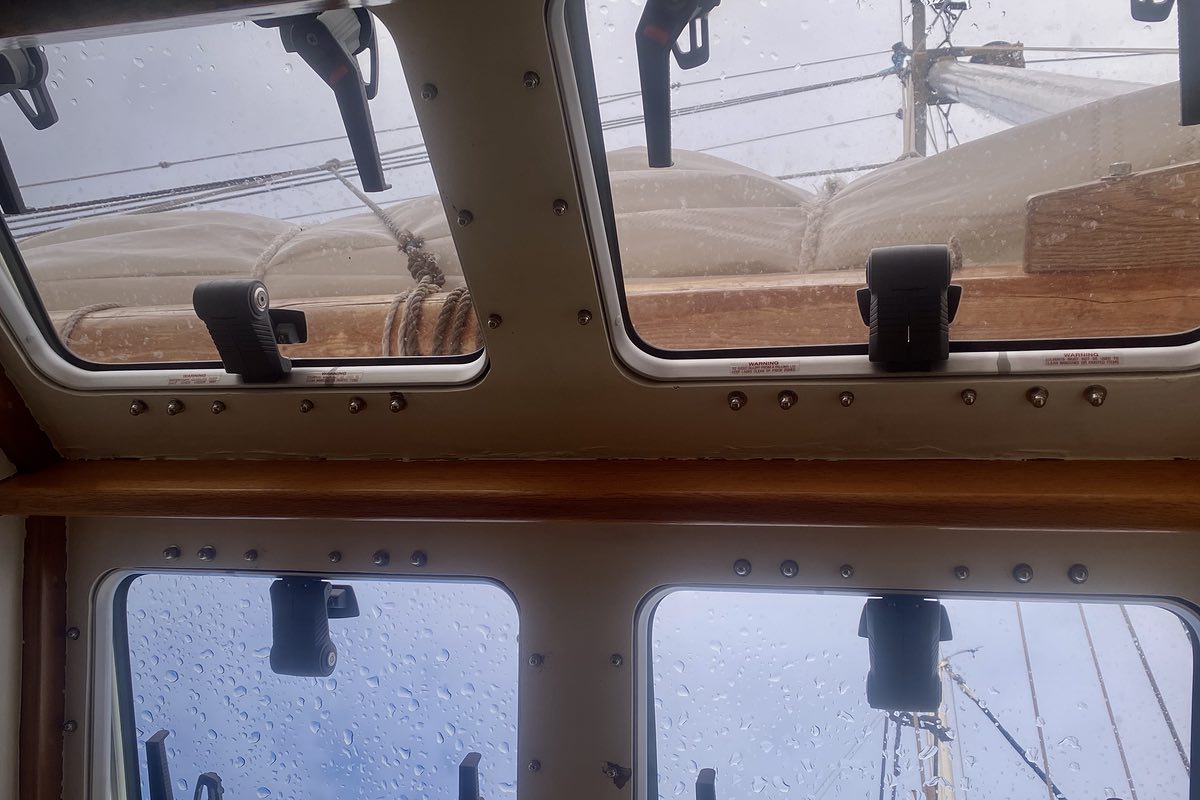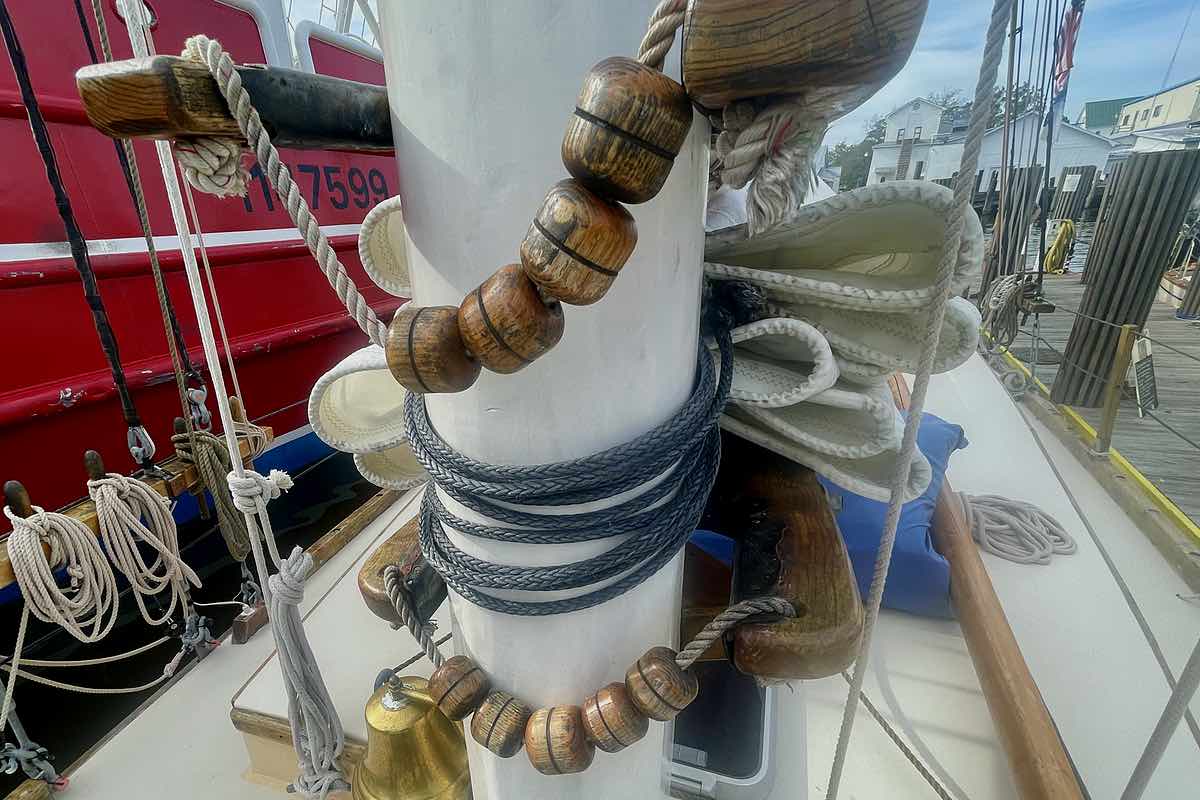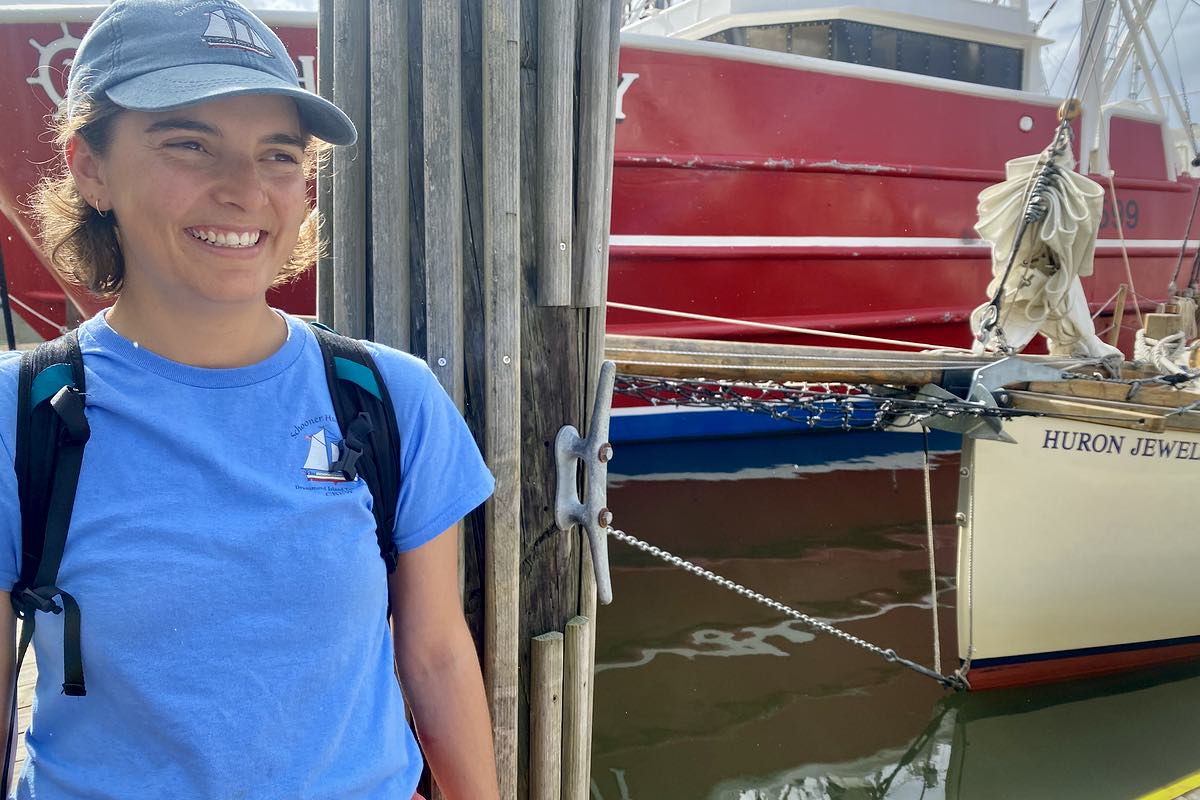It's Monday January 5, 2026

Lots of boats come to Oriental, some tie up at the Town Dock for a night or two, others drop anchor in the harbor for a while. If you've spent any time on the water you know that every boat has a story. The Shipping News on TownDock.net brings you the stories of the boats that have visited recently.
November 22, 2022
It’s always a sight to see a schooner under full sail, but it took on another vision entirely when the 78 foot, homebuilt wooden schooner Huron Jewel silently ghosted away from Oriental Halloween morning.
Huron Jewel departing Oriental.With no engines running and no helmsman at the wheel, a gem of the Great Lakes looked like a ghost ship from the mainmast aft. Forward, the captain and first mate orchestrated their crew of volunteers, ranging in age from 24-60 years old. The schooner moved silently under sail amidst interspersed puffs of light wind, on an otherwise completely flat Neuse River.
Schooner Huron Jewel had docked in Oriental during an unusually balmy early November weekend.
Huron Jewel, wedged in at the free dock.The owners are the boatbuilders; married couple Capt. Hugh and first mate Julie Covert. Julie also holds a captain’s license from the US Coast Guard. Along with their crew of volunteers, the couple enthusiastically offered free schooner tours above and below decks while tied up in the harbor.
Hugh at the helm of Huron Jewel.Huron Jewel and crew settled in at the town dock, a tight squeeze between commercial fishing boats and visiting yachts. Raindrops from passing clouds did not deter the guests filtering on and off the wooden vessel. They signed the ship’s log and admired the schooner’s uncommon design and construction. Meanwhile, Julie and Hugh explained that their “ship of dreams” was once just that.“You just have to start. That’s the hardest part,” said Hugh, a professional tall ship captain clad in steel toe boots and loose fitting Wranglers. “I kept wishing someone would bring a boat closer home, that never happened so I had to build one.”
Julie and Hugh, alternate heating and cooking options, and a few facts about Huron Jewel.Homeport is Drummond Island on Lake Huron in Michigan. It is a harbor of refuge and boater’s haven for those traveling through Lake Huron, Lake Michigan, and Lake Superior. The island is popular with landlubbers as well for water tourism, albeit with a very short visiting season.
All that was really missing was a company that offered day sailing to those visiting the island from dry land.
They decided to build that company.
They came up with a plan and a mission statement. They put what they had to on credit, took out business loans, cashed in 401Ks, and found dozens of volunteers to help. Not only did they have to build a business, but they had to build a boat. In an effort to live a life they didn’t need a vacation from, they created the Drummond Island Tall Ship Company, and the subsequent “Dream Tour” which they are on now. They launched in 2018.
Huron Jewel utilizes multiple informational devices, modern and otherwise.“Whatever goal you have, put it to paper first,” Julie said from the galley, preparing a large batch of what she called “schooner lasagna.” The recipe is in the Schooner Rag; a newspaper she created. A few issues are available on the table to port, along with other general info and merchandise. A basket with some local goods is adorned as a centerpiece. A trophy Huron Jewel won for Best Owner Built Vessel at the Manteo Wooden Boat Show on Roanoke Island – their last port of call before Oriental – sits nearby.
“Hugh is very humble,” Julie said of her husband’s boat building and boat handling skills.
Bowsprit reflection in Oriental’s harbor.Julie is also the publisher and editor of the local newspaper on Drummond Island and is the sole staff member of the now decades old paper, which Julie bought from its original founder. She brought business management, creative and marketing skills to the tour, while Hugh brought practical boat building experience, sea time, and seamanship.
“Skills are more of a commodity than money,” Hugh said. “We want to share that.”
A look at one of the crew’s bunks.Tapping into the tall ship touring circuit the Coverts and their crew of volunteers have been traveling and showcasing the vessel from port to port for nearly 3,500 nautical miles. From the Great Lakes and canal systems, to the St. Lawrence Seaway, the Gulf of Maine, the coast of New England, New York and New Jersey, the Chesapeake Bay, Dismal Swamp Canal to the Pamlico Sound. They’ll go all the way to the Bahamas with a few stops in the Everglades and Gulf waters of Florida.
When they get back, it will be time to run day sails and up to week-long private charters again on Lake Huron.
“It’s a very short season,” Hugh says, with an almost nervous laugh.
“We don’t really make any money,” Julie said. “We’re doing it because we love it.”
Lines, blocks, and wood details on deck and below.The business model, however, has generated attention. Over fifty volunteers helped build the vessel, and several others sail onboard during the tour in exchange for room, board, and education. In return they help Hugh and Julie run a tight ship.
“After this, our volunteers can get a job on a boat as a mate. A better paying job than we could offer,” Hugh said.
The ship has served as a major attraction in every port on their itinerary. From the tip of the bowsprit to the flat transom astern, the sheer line is that of a traditional Sharpie schooner, a design once used commercially for carrying cargo and oyster dredging on the shallow waters of the Outer Banks. Later, smaller versions of the Sharpie became popular recreationally in North Carolina and Chesapeake Bay, built in people’s backyards.
Raising the sail.The schooner Huron Jewel, however, is far from either a traditional working or recreational Sharpie. Its unique design and sailing capabilities came from Hugh drawing on his unique lifelong experience sailing, the nine other boats he’d built prior, and a career captaining tall ships of all kinds. His approach has results onboard, where traditional meets modern.
“Sort of a modified Sharpie schooner,” Hugh said of his design. “It’s not flat bottomed like a true Sharpie. It has an arc to it. And a modern construction between strip planked and cold molded.”
Julie listens in while Hugh talks about the construction process.Built with over 30 types of wood, the frame is Douglas Fir tongue and groove 2×6s. Hugh, Julie, and the help of friends and volunteers planked the boat “in a long weekend.” The next layer is plywood, then epoxy and fiberglass cloth on the outside. The deck as well as the cabin tops are integral to the structural integrity of the vessel and keep the hull from flexing and twisting; with two layers of half-inch plywood laid with staggered joints and finished with layer of polyester cloth and resin. The schooner is 60 feet on deck but 78 overall with the bowsprit.
Huron Jewel’s keel includes 12,000lbs of lead ballast in a shoal draft and skeg, with a drop down centerboard. Two folding propellers for twin Yanmar diesel engines allow for tight maneuvering in busy commercial ports like Baltimore or the tiny harbor of Oriental, and also serve as redundancy in case of engine failure. The centerboard is electric. The heads’l is on a roller furler on the bowsprit. The lifelines are Dyneema. The sails, cruising Dacron. Somewhat to Hugh’s chagrin, he said.
Huron Jewel, open for tours.“You can’t get cotton colored sails. I tried with my sailmaker. But they’d be destroyed by the UV rays. Dyneema actually looks pretty traditional. The furler on the bowsprit is becoming industry standard. It allows for less people to run the ship, which is less overhead.”
The rig is that of a traditional two masted, gaff rigged schooner. The spars are all wood, comprised of northern white spruce and old growth short leaf yellow pine. The booms and gaffs are solid wood, and the masts are hollow built from pieces glued together. The standing rigging is galvanized steel, parceled and served with tar and twine. Sails are set and struck with halyards going to pinrails. There are no winches on the boat and the crew, with the help of passengers, “sweat” the lines themselves to take up tension. Huron Jewel has modern navigation and emergency electronics, but no autopilot.
A mix of modern and traditional: Dyneema hoops, modern hatches, and a wooden gaff.Construction of the boat and subsequent outfitting of essential equipment has made for overall good performance. It has proven itself since the launch in 2018 in conditions of all kinds. Captain and crew have seen it with up to 12 foot seas offshore, 15-knot perfect days with guests on Lake Huron, and ghosting in barely a breath of wind on the Neuse River.
“The boat is optimized for reaching across the wind,” Hugh said. “It’s just perfect for the lake and the coast.”
Volunteer Victoria Southwick.Victoria Southwick is a 26-year-old volunteer crew member on Huron Jewel. She has sailing experience from growing up on an island in Vermont on Lake Champlain. She’s also crewed on racing yachts and has a Competent Crew sailing certification from a course in Portugal. Her degree from the Savannah College of Art and Design landed her a gig as an industrial design consultant. She quit to pursue a more adventurous career and joined Huron Jewel to take her sailing skills to the next level.
For Victoria, the experience is priceless.
“This is big water cruising experience, learning to go from port to port, with entire days where you don’t see land,” she said. “And to be able to sail on a boat like this with an almost flat bottom, and these wonderful chines. There’s very little drag at all.”
Working with the schooner’s lines is a team effort.Captain Hugh and Julie both like to look out for “signs;” little coincidences from the universe to help them justify taking risks for the sake of joy, whether personally or in their careers. Like when Captain Hugh wasn’t sure if he should go back to work on commercial tugboats and barges. It certainly paid better than captaining tall ships, but he was a sailor at heart. Or when Julie moved halfway across the country to live on a small island in Michigan with Hugh; she’d always wanted to write, but was a career message therapist.
“I was tired of always working on somebody else’s boat and being away from home. Feeling like I didn’t have a home,” Hugh said.
Crew working opposite ends of Huron Jewel.Though he quit the tugboats and barges, Hugh would continue sailing tall ships. From a square rigger brigantine, to the 137 foot educational flagship of Wisconsin, to developing the Bahamas charter model on the windjammer Liberty Clipper.
It was in Baltimore some odd years later, where he met his true first mate in life, and ultimately work, and would go on to finally build that ship of his own he’d been dreaming about working on. The day TownDock.net toured Huron Jewel, was in fact, the anniversary of the day Hugh and Julie first met.
Building their dream ship and preparing for the voyage that would follow was once nothing more than a vision the Coverts had in mind. Perhaps that’s why the sight of Huron Jewel under full sail, or even tied to the town dock, is something to behold.
Story by Emily Greenberg.
Photos by Emily Greenberg, Ashley Haley, and Keith Smith.
Video by Ashley Haley, Keith Smith, and edited by Allison DeWeese.

























